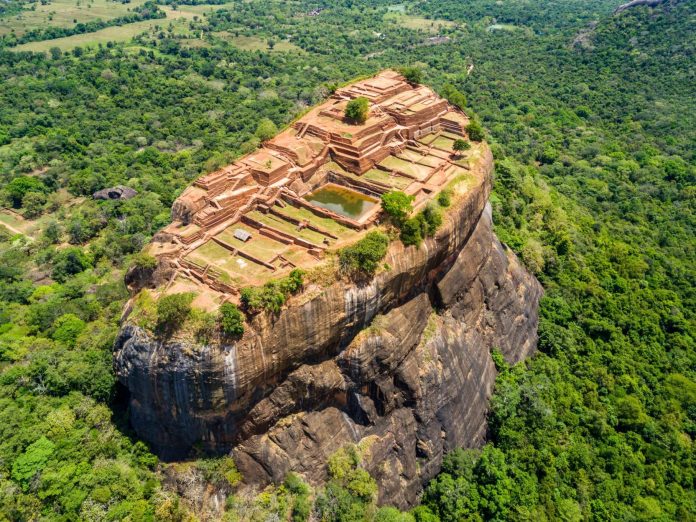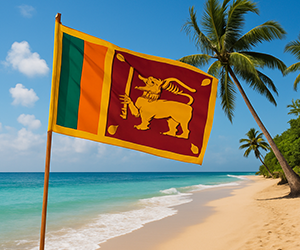Nestled in the heart of Sri Lanka’s Cultural Triangle, Sigiriya Rock Fortress, also known as the Lion Rock, stands as a testament to the island’s rich history and architectural prowess. This UNESCO World Heritage Site is not only a marvel of ancient engineering but also a symbol of the country’s cultural heritage.
A Glimpse into History
The origins of Sigiriya date back to the 5th century AD during the reign of King Kashyapa I. After seizing the throne from his father, King Dhatusena, Kashyapa sought a new capital to fortify his rule. He chose the towering rock of Sigiriya, transforming it into an elaborate city complex complete with palaces, gardens, and defensive structures. The site served as the royal residence for nearly two decades before being abandoned after Kashyapa’s death. Subsequently, it functioned as a Buddhist monastery until the 14th century.
Architectural Marvels
The Lion Gate
One of Sigiriya’s most iconic features is the Lion Gate, a grand entrance adorned with massive lion paws carved into the rock. These remnants suggest that visitors once entered through the open mouth of a colossal lion structure, symbolizing strength and protection.
The Mirror Wall and Frescoes
Midway up the rock, the Mirror Wall showcases ancient graffiti dating back to the 8th century. These inscriptions, penned by visitors, offer insights into the thoughts and expressions of early travelers. Adjacent to the wall are the renowned Sigiriya frescoes, depicting celestial maidens in vibrant hues, reflecting the artistic excellence of the era.
The Summit Palace
Atop the 200-meter-high rock lie the ruins of King Kashyapa’s palace complex. The summit offers panoramic views of the surrounding landscapes, and remnants of royal chambers, pools, and throne rooms provide a glimpse into the opulence of ancient royalty.
The Ingenious Water Gardens
Surrounding the base of Sigiriya are meticulously designed water gardens, showcasing advanced hydraulic engineering. These gardens feature symmetrical pools, fountains, and canals, many of which still function during the rainy season, highlighting the ingenuity of ancient Sri Lankan architects.
Cultural and Religious Significance
Beyond its architectural feats, Sigiriya holds deep cultural and religious importance. The site’s transformation from a royal citadel to a monastic retreat underscores its spiritual resonance. The amalgamation of secular and sacred elements reflects the harmonious coexistence of governance and religion in ancient Sri Lankan society.
Visiting Sigiriya: What You Need to Know
Best Time to Visit
The optimal period to explore Sigiriya is during the dry season, from December to April. During these months, the weather is conducive to climbing and sightseeing, offering clear views and comfortable conditions.
Entrance Fees and Timings
- Opening Hours: 7:00 AM to 5:30 PM daily
- Entrance Fees:
- Foreign Adults: $35
- Foreign Children: $20
- SAARC Country Adults: $20
- SAARC Country Children: $10
- Sri Lankan Adults: LKR 100
- Sri Lankan Children: LKR 50
Note: Prices are subject to change; it’s advisable to check the official website or local sources before planning your visit.
Climbing Tips
- Footwear: Wear sturdy, comfortable shoes suitable for climbing.
- Hydration: Carry sufficient water, especially during warmer months.
- Sun Protection: Use sunscreen, hats, and sunglasses to shield against the sun.
- Guides: Hiring a local guide can enrich your experience with historical insights.
Nearby Attractions
Pidurangala Rock
Located just a few kilometers from Sigiriya, Pidurangala Rock offers a less crowded alternative with equally breathtaking views. The summit provides a panoramic vista of Sigiriya Rock, making it a popular spot for sunrise hikes.
Dambulla Cave Temple
A short drive away, the Dambulla Cave Temple is a UNESCO World Heritage Site featuring a series of caves adorned with Buddhist murals and statues. This sacred site offers a deeper understanding of Sri Lanka’s religious heritage.
Sigiriya in Modern Context
Today, Sigiriya stands as a symbol of Sri Lanka’s rich cultural tapestry and architectural brilliance. Its preservation and global recognition underscore the importance of safeguarding historical landmarks for future generations. For travelers and history enthusiasts alike, Sigiriya offers an unparalleled journey into the past, blending natural beauty with human ingenuity.
For more insights and travel guides on Sri Lanka’s hidden gems, visit lanka.guide.




